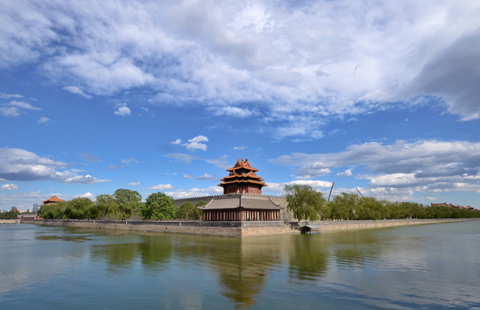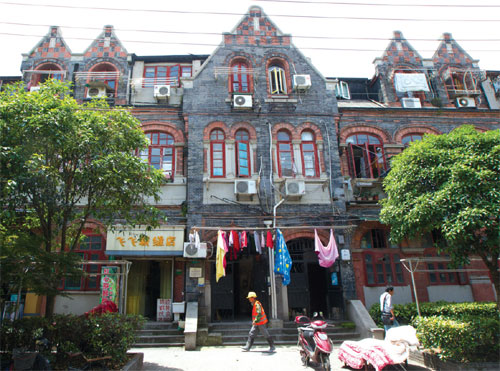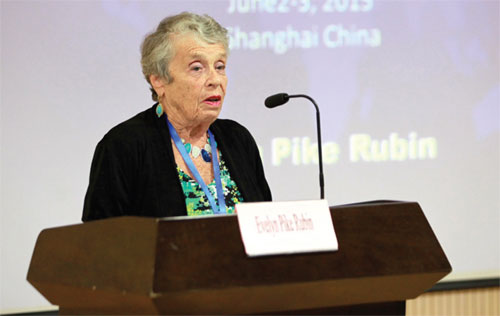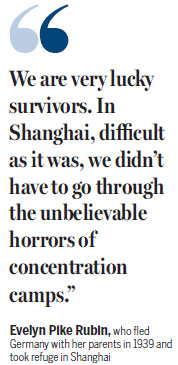Jewish war refugees remembered
Updated: 2015-06-12 11:32
By Li Xueqing in Shanghai(China Daily USA)
|
||||||||
|
Neighborhood in Hongkou district where European Jews lived during World War II. [Photo by Gao Erqiang / China Daily] |
Thousands of Jews fled Europe and landed in Shanghai during World War II, and survivors and others gathered this month to recall events of the historic, painful era
Searching for their own names eagerly on a huge bronze wall, Jews from different parts of the world gathered in Shanghai Jewish Refugees Museum last week to commemorate the 70th anniversary of the survival of Jewish refugees in Shanghai during World War II.
During the war, the Shanghai Jewish Refugees Museum was then the Ohel Moshe Synagogue, where Jews socialized with each other. During that time, at least 18,000 Jews took refuge in Shanghai to escape from Nazi persecution. Most of them survived and went on to settle in other countries after the war, including the US, Canada, Israel and Australia.
As another part of the commemoration, a three-day conference that began on June 1 was held in Shanghai University of International Business and Economics. Holocaust scholars joined people who lived through the period in Shanghai, sharing stories that are not commonly known.
"The timing of this event is very important and special," said Patricia E. Salkin, dean and professor of law at Touro Law Center, who co-hosted the conference. "If they have been alive till now, those European Jewish refugees would be at least at their 70s. We are losing time to hear personally from the eye witnesses."
Hard to become a refugee
"We are very lucky survivors," said Evelyn Pike Rubin, an 85-year-old author and lecturer who lives in Jericho, New York. "In Shanghai, difficult as it was, we didn't have to go through the unbelievable horrors of concentration camps."
Rubin boarded a ship in Naples, Italy, with her parents in February 1939 and landed in Shanghai a month later. According to her, it was not a preferred destination. But after their attempts of getting an American visa failed, Shanghai, the only place then that required no entry document, became their only option.
Her mother had felt the urge to leave Germany after Hitler assumed power in 1933 when anti-Semitic policies began in Germany; but her father, a World War I German veteran and an optimist, thought otherwise.
"He said, 'I don't think so. I fought for this country. This mad man (Hitler) isn't going to last.'"
Whether to leave or not was a struggle that every Jewish family had gone through, even after 1938 when anti-Semitism further exacerbated, said Steve Hochstadt, professor of history at Illinois College in Jacksonville, Illinois. He is a Holocaust expert and descendent of Viennese Jews who fled to Shanghai.
In March 1938, Germany annexed Austria, known as "Anschluss". Then the Kristallnacht, or the Night of Broken Glass, broke out on November 9, 1938. Through the next day, synagogues were burned in Germany and Austria, window glass shattered. Thousands of Jews were sent to concentration camps.
"However, it was hard to become a refugee," said Hochstadt.
To leave, Jews had to submit proof of emigration, such as an entry visa, an affidavit or a ship ticket to other countries and go through tedious procedures before the Gestapo.
They queued up in front of consulates, trying to squeeze into other countries' immigration quotas, which were far from enough.
And their money and valuables had been taken away. This made it more difficult for them to book the expensive first class tickets of Italian, Japanese and other shipping liners, which required them to buy round-trip tickets, Hochstadt said.
The sea route from ports in Italy to Shanghai was a common course taken by the refugees before Italy declared war against the Allies on June 10, 1940. After that, the only route that remained open was to traverse Siberia to Northeast China by train.
Among people who extended their help, there was Ho Feng Shan, who was honored "Righteous among the Nations" posthumously by Israel in 2000 for "his humanitarian courage" in the rescue of Austrian Jews.
Ho was the consul-general of China in Vienna from 1938 to 1940. He issued thousands of visas with Shanghai as the end destination. Though the Chinese nationalist government then lost control of Shanghai to the Japanese in 1937, the city's port remained open to all visitors.
With the Shanghai visa, Austrian Jews were released from concentration camps. They were also able to get transit visas or temporary visas to other destinations. The majority of them finally landed in the US, Britain, Palestine, Cuba and the Philippines, said Ho Manli, daughter of Ho Feng Shan and a trained journalist. She's been uncovering this story for more than a decade.
The exact number of visas issued under Ho Feng Shan's watch is hard to find out today.
"The best we can determine now is thousands, based on the serial numbers of some still existing visas and surviving documentation," said Ho Manli. "The consulate issued an average of 400 to 500 visas a month to Jewish refugees starting in 1938 through 1939."
Words spread about Shanghai from Austria to Germany, which led many German Jews to Shanghai, including Rubin and her family.
From "Little Vienna" to ghetto
European Jews poured in to Shanghai in 1938 and 1939. Some of them were able to bring silver dishes and furniture, many came with a bag and little fortune.
The local Jewish community of approximately 6,000 people came to help the newcomers to establish their new life in the city whose economy had been largely damaged by the war. Baghdadi Jews came in the 1840s for business opportunities. Then Russian Jews arrived at the turn of 20th century to escape persecution. They organized relief work in collaboration with international organizations and helped the refugees get jobs and language training.
Five group homes were set up to provide shelter to those newcomers or the homeless. Communal kitchens provided meager meals to the refugees.
Those who still could afford high rents settled down in the former French Concession. But most of the refugees found their new homes in Hongkou district, where rents and food prices were considerably lower. Despite all the difficulties, businesses were opened. New restaurants, cafs and bars popped up in Hongkou, gaining the place the reputation of "Little Vienna".
Rubin's mother managed to bring her fine china, linens and laces and gave them to the thrift shop of the Baghdadi Jews in Shanghai. With the money, she established a small business and bought a small apartment in the former French Concession. One year later, her grandmother, who had been reluctant to leave Germany, joined them.
Their situation aggravated after the Japanese attacked Pearl Harbor on December 7, 1941. In 1943, a "Designated Area for Stateless Refugees", or the "ghetto" as Rubin calls it, was set up in Shanghai. The Japanese ordered all the stateless refugees who had arrived after 1937 to move into an area of less than 2.5 square kilometers in Hongkou with few exceptions.
Strict curfew was enforced. Any refugee who wanted to go out to see the doctor or earn a living needed to get a pass. There they were subjected to the humiliation of Kano Ghoya, the Japanese officer who notoriously called himself "King of the Jews". Ghoya had a reputation of slapping people's faces and rejecting a pass simply because he was in a mood.
Some were hit especially hard for leaving their homes and businesses again. By early 1944, 5,000 to 6,000 people had to depend on the communal kitchens to survive, which provided only one hot meal and 255 grams of bread a day, David Kranzler wrote in his book Japanese, Nazis & Jews: the Jewish Refugee Community of Shanghai, 1938-1945.
Rubin's father died in 1941 at the age of 43. Her grandmother died two years later. Her mother's business was down the drain. They moved into a slum house in the designated area to share with 10 people.
The designated area was officially abolished on September 3, 1945. Former refugees revisited Hongkou, including the American graphic artist Peter Max. He came in 2012 to look for his Chinese nanny who introduced him to drawing when he was a little boy in the ghetto.
Michael Blumenthal, the Secretary of the Treasure under President Jimmy Carter, has come back to Shanghai eight times. He fled with his family from Germany in 1939 and spent eight years here. During the most difficult time, he had to quit school and did a number of jobs including working for a chemical lab.
China has been part of his life, he told China Daily in 2011.
lixueqing@chinadaily.com.cn

 Across America (June 5-11)
Across America (June 5-11) Warriors top Cavaliers to square up NBA Finals
Warriors top Cavaliers to square up NBA Finals
 Top 10 most expensive private schools in Beijing
Top 10 most expensive private schools in Beijing
 Want new ear or car? Try 3-D printing
Want new ear or car? Try 3-D printing
 Ten photos you don't wanna miss - June 12
Ten photos you don't wanna miss - June 12
 Beijing enjoys clear skies
Beijing enjoys clear skies
 Top 10 investor countries and regions
Top 10 investor countries and regions
 Beijing showcases Olympic exhibits and visions
Beijing showcases Olympic exhibits and visions
Most Viewed
Editor's Picks

|

|

|

|

|

|
Today's Top News
Fan meets veterans and families
Former security chief sentenced to life in prison
Top brass visit Pentagon
China committed to addressing climate change
Murdoch's sons to become CEO, co-chair at 21st Century Fox
Carter greets General Fan at Pentagon
Pentagon to greet General from China
Helping the Hill understand China
US Weekly

|

|








